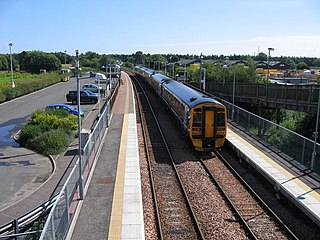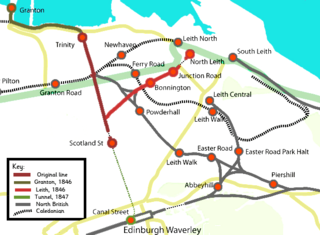
The North British Railway was a British railway company, based in Edinburgh, Scotland. It was established in 1844, with the intention of linking with English railways at Berwick. The line opened in 1846, and from the outset the company followed a policy of expanding its geographical area, and competing with the Caledonian Railway in particular. In doing so it committed huge sums of money, and incurred shareholder disapproval that resulted in two chairmen leaving the company.
Leven is a seaside town in Fife, set in the east Central Lowlands of Scotland. It lies on the coast of the Firth of Forth at the mouth of the River Leven, 8.1 miles (13.0 km) north-east of the town of Kirkcaldy and 6.4 miles (10.3 km) east of Glenrothes.

The Fife Circle Line is the local rail service north from Edinburgh. It links towns of south Fife and the coastal towns along the Firth of Forth before heading to Edinburgh. Operationally, the service is not strictly a circle route, but, rather, a point to point service that reverses at the Edinburgh end, and has a large bi-directional balloon loop at the Fife end.

Burntisland railway station is a railway station in the town of Burntisland, Fife, Scotland. The station is managed by ScotRail and is on the Fife Circle Line.

Kinghorn railway station is a railway station in the town of Kinghorn, Fife, Scotland. The station is managed by ScotRail and is on the Fife Circle Line, 22+3⁄4 miles (36.6 km) north east of Edinburgh Waverley.

Glenrothes with Thornton railway station serves the communities of Glenrothes and Thornton in Fife, Scotland. The station is managed by ScotRail and is on the Fife Circle Line, 31+1⁄4 miles (50.3 km) north of Edinburgh Waverley.

Cowdenbeath railway station is a railway station in the town of Cowdenbeath, Fife, Scotland. The station is managed by ScotRail and is on the Fife Circle Line, 22+1⁄2 miles (36.2 km) north of Edinburgh Waverley.

Dunfermline Queen Margaret railway station is a railway station in Dunfermline, Fife, Scotland. The station is managed by ScotRail and is on the Fife Circle Line, 18+1⁄2 miles (29.8 km) north of Edinburgh Waverley. The station takes its name from the nearby Queen Margaret Hospital. It is the longest railway station name in Scotland.

Dunfermline City railway station is a station in the city of Dunfermline, Fife, Scotland. The station is managed by ScotRail and is on the Fife Circle Line, 17 miles (27 km) north of Edinburgh Waverley.

Ladybank railway station serves the town of Ladybank in Fife, Scotland.
Levenmouth is a conurbation comprising a network of settlements on the north side of the Firth of Forth, in Fife on the east coast of Scotland. It consists of three principal coastal towns; Leven, Buckhaven, and Methil, and a number of villages and hamlets inland. The industrial towns of Buckhaven and Methil lie on the west bank of the River Leven, and the resort town of Leven is on the east bank. The "Bawbee Bridge" links the two sides of the river. Historically, Buckhaven and Methil were joined together as one burgh, while Leven was separate. The area had an estimated population of 37,238 in 2006.
The Kincardine Line is a railway in Clackmannanshire and Fife, Scotland. It was originally built to serve settlements along the north shore of the Firth of Forth, between Alloa and Dunfermline.

Thornton is a village in Fife, Scotland. It is between Kirkcaldy and Glenrothes, and stands between the River Ore and Lochty Burn, which are at opposite ends of the main street. The Church of Scotland parish church was built in 1835 and is located on the Main Street.
The Edinburgh and Northern Railway was a railway company authorised in 1845 to connect Edinburgh to both Perth and Dundee. It relied on ferry crossings of the Firth of Forth and the Firth of Tay, but despite those disadvantages it proved extremely successful. It took over a short railway on the southern shore of the Forth giving a direct connection to Edinburgh, and it changed its name to the Edinburgh, Perth and Dundee Railway.
The Levenmouth rail link is a planned scheme to re-open 5 miles (8 km) of railway line in Fife, Scotland. The link will connect the town of Leven and other settlements in the Levenmouth conurbation with Thornton, and will join the Fife Circle Line at Thornton North Junction. The line is being promoted by Fife Council and the South East Scotland Transport Partnership (SESTRAN). The plan was approved by the Scottish Government on 8 August 2019.

The Edinburgh, Leith and Newhaven Railway was a railway company formed in 1836 to connect the city of Edinburgh with the harbours on the Firth of Forth. When the line connected to Granton, the company name was changed to the Edinburgh, Leith and Granton Railway. It opened part of its route in 1846, but reaching the centre of Edinburgh involved the difficult construction of a long tunnel; this was opened in 1847. It was on a steep incline and was worked by rope haulage.
The St Andrews Railway was an independent railway company, founded in 1851 to build a railway branch line from the university town of St Andrews, in Fife, Scotland, to the nearby main line railway. It opened in 1852. When the Tay Rail Bridge opened in 1878 residential travel to Dundee was encouraged.
The Fife Coast Railway was a railway line running round the southern and eastern part of the county of Fife, in Scotland. It was built in stages by four railway companies:
The Wemyss and Buckhaven Railway was a railway company that built a line in the county of Fife in Scotland, connecting Buckhaven with the main line railway network at Thornton, and linking with collieries.
The Railways of Kinross were a local network of three rural railways which made the town of Kinross in Scotland their objective in the 1850s.











